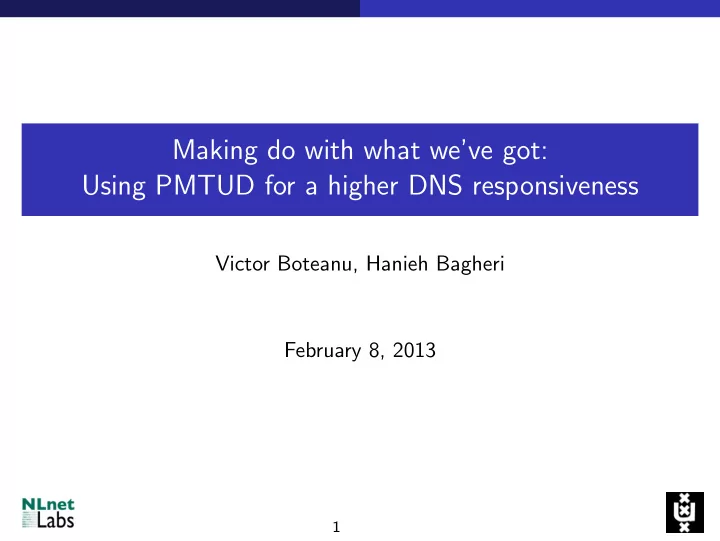

Making do with what we’ve got: Using PMTUD for a higher DNS responsiveness Victor Boteanu, Hanieh Bagheri February 8, 2013 1
Introduction Classic DNS: - Normally uses UDP - A few truncated responses - > TCP Emergence of EDNS0 and DNSSEC - Bigger responses: RRset + signature - Capability of using UDP for responses > 512 bytes - fragmentation instead of truncation 2
Fragmentation in IPv6 only done on end-to-end hosts Path MTU Discovery (PMTUD) - finding the smallest MTU in the path - ICMPv6 Packet Too Big (PTB): MTU + the trimmed part of the original message 3
Research question Would it be feasible to utilize ICMPv6 PTB messages to increase a name server response deliverability? What strategies can be applied and what effects and risks would they have? 4
Previous Research Maikel de Boer and Jeffrey Bosma: - IPv6 path MTU black hole discovery Gijs van den Broek et. al.: - Monitoring real-world resolvers dealing with fragmented DNS responses - Two server-side solutions to prevent fragmentation 5
Motivation Fact 1: About 10% of firewalls filter IPv6 fragments - Send responses with the min size guaranteed by all the routers: 1232 bytes Fact 2: ICMPv6 PTB message: original message contains (besides headers) the trimmed response Fact 3: Name servers are not aware of the PTB messages - DNS responses may become lost without informing the name server 6
Idea Our idea: - Ability to handle the failed responses due to their big size - Send larger responses than 1232, but still less than 1452 Expected Result: - Decrease number of fragments - Increase the responsiveness of name servers 7
Proposed solution 1 Simply send the response again to the client and set the TC flag The client should send the query again using TCP Implications: - Prevents DNS ID hacking 8
Proposed solutions 2 and 3 Solution 2 - Use the PTB message payload to resubmit query to the name server Solution 3 - Use the PTB message payload to create shorter answers - for example omitting the ADDITIONAL section - making correction to decrease the value of the EDNS0 option Implications: - With both solutions, we circumvent ICMPv6 PTB spoofing 9
Setup and resources NSD 3.2.14 running on NLNOG RING node IPv6 only, no filtering RIPE Atlas probes (only IPv6) Packet captures provided by SURFnet DNS traffic provided by SIDN 10
Setup and resources 11
Setup and resources 12
Setup and resources Number of IPv6 ready probes - around 850 Available for our experiment - 442 TXT record > 1500 bytes (1560 response size) MTU on Ring-server interface set to 1280 Query TXT record from all Atlas probes 13
Results and observations Probe PMTU 70 60 50 Number of Probes 40 30 20 10 0 0 0 2 2 6 0 6 8 4 4 0 0 4 0 0 8 8 9 7 7 6 5 6 6 5 5 4 3 9 8 4 2 4 4 4 4 4 4 4 4 4 4 4 3 3 1 1 1 1 1 1 1 1 1 1 1 1 1 1 1 PMTU 14
Results and observations SIDN response sizes (DNSSEC IPv6 only) Capture time of 2h Sizes Number of responses ≤ 1232 bytes 99.66% (1232, 1452] bytes 0.002% > 1452 bytes 0.32% 15
Results and observations SURFnet response sizes (IPv6) Capture time of 1h on 7 name servers Sizes Number of responses < 1232 bytes 97.77% (1232,1452] bytes 2.14% > 1452 bytes 0.07% 16
Results and observations Atlas probe experiment - PTB and Fragment Reassembly messages 34 probes sent back Fragment reassembly messages 1 probe sent back PTB message despite MTU of server set to 1280 This probe only accepted messages of at most 1232 bytes 17
Results and observations SIDN and SURFnet - ICMPv6 messages Type of message SIDN SURFnet Time Exceeded Fragment Reassembly 333(8.1%)* 26(0.06%) Packet Too Big 43(1%) 16(0.03%) Administratively prohibited 7991 3624(8.1%) *out of response sizes > 1232 bytes 18
Implementation of Solution 2 427 unique sources query TXT record Raw socket intercepting packets handled 56 problematic sources only 5 probes still sent back Fragment Reassembly 19
Conclusions DNSSEC gaining in popularity Responses will grow in size Firewalls are still configured to filter fragments ICMPv6 messages are not used their full potential 20
Questions 21
Recommend
More recommend